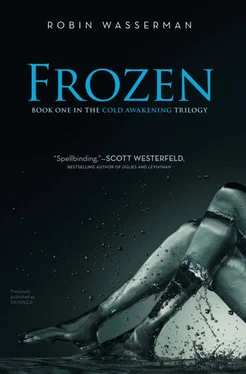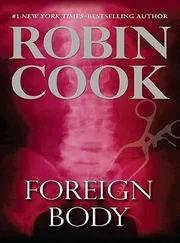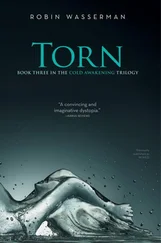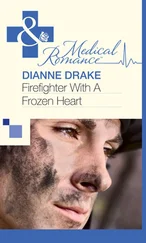Jude stripped out of his suit, balled it up, and tossed it across the plane. “Funny how I tend to have that effect on people.”
“Oh, please.” I stabbed a finger down my throat. “Do not start lumping me in with your groupies.”
“They’re not groupies.”
But I could tell he enjoyed the designation. “What would you call them?”
“They’re lost, searching for answers—can I help it if they come to me?” Jude crossed his arms, pleased with himself. “I suppose I’d call them wisdom seekers.”
“And they’re seeking it in your pants?”
“So vulgar.” Jude tsked. “When the problem is your body, it’s not so difficult to imagine that the body is where the solution lies.” He reached for my hand, but I snatched it away.
“Save it for the groupies.”
“What?” he asked, amber eyes wide with innocence.
I turned my back on him, watching the clouds stream by. Even now there was something disconcerting about being up in the air without a pilot. Self-navigating cars were the norm—these days, only control freaks drove themselves—but the self-piloting planes were fresh on the market, powered by some new smarttech that, according to the pop-ups, was the world’s first true artificial intelligence. Unlike the smartcars, smart-fridges, smarttoilets, smarteverything we were used to, the new tech could respond to unforeseen circumstances, could experiment, could learn . It could, theoretically, shuttle passengers at seven hundred miles an hour from point A to point B without breaking a sweat. It just couldn’t smile and reassure you that if a bird flew into the engine, it would know what to do.
Not that there were many birds anymore.
Especially where most of the AI planes were destined to fly, the poison air of the eastern war zones. This was military tech; action at distance was the only way to win without having to fight. Thinking planes, thinking tanks, thinking landcrawlers equipped with baby nukes saved orgs from having to think for themselves. Saved them from having to die for themselves. Not many had credit to spare to snatch up a smartplane of their own for peacetime purposes—but as far as Quinn was concerned, no luxury was too luxurious, especially when Jude was the one placing the request.
The ground was hidden beneath a thick layer of fog, and it was tempting to imagine it had disappeared. “Flying’s getting old,” I said, keeping my back to Jude.
“For you maybe.”
“We need to find something better.” More dangerous, I meant. Wilder, faster, steeper. Bigger .
“You want better?” He slipped a small, hard cube into my palm. “For later.”
“You know I don’t do that crap.” But I closed my fingers around it.
“For later,” he said again. So smug.
I just kept staring out the window, wondering what it would feel like if the plane crashed. How long would we stay conscious, our mangled bodies melting into the burnt fuselage? Would we be aware as fuel leaked from the wreckage, lit by a stray spark? What would it feel like at the moment of explosion, our brains and bodies blasted into a million pieces?
I would never know. The moment this brain burst into fire, someone at BioMax would set to work retrieving my stored memories, downloading them into a newly made body, waking me to yet another new life. That “me” would remember everything up to my last backup and nothing more. No flying, no crashing, no explosion.
For the best, I decided. Maybe when it came to dying, once was enough.
ROBIN WASSERMAN is the author of the Cold Awakening trilogy ( Frozen, Shattered, Torn ), Hacking Harvard , the Seven Deadly Sins series, and the Chasing Yesterday trilogy. She lives in Brooklyn, New York.
“A spellbinding story about loss, rebirth, and finding out who we really are inside.”
—Scott Westerfeld,
New York Times bestselling author of the Uglies series
“Set in a well-drawn future world highly reminiscent of M. T. Anderson’s Feed … Futuristically blurring the boundaries of life and death, this text intimately tackles tough ethical topics, including faith, identity, suicide, and genetic engineering, through blunt dialogue and realistic characters.”
—
Kirkus
“Well composed and engaging, this is an obvious choice for readers of Peter Dickinson and George Orwell.”
—
Booklist
“Wasserman paints her protagonist undergoing a realistic and dramatic transformation … ample futuristic technology to draw in science-fiction buffs, even if the ultimate focus is a more contemplative coming-of-age story.”
—
BCCB
“An interesting and engaging look at medical ethics and humanity.”
—teensreadtoo.com
The Cold Awakening trilogy
Hacking Harvard
The Seven Deadly Sins series
This book is a work of fiction. Any references to historical events, real people, or real locales are used fictitiously. Other names, characters, places, and incidents are the product of the author’s imagination, and any resemblance to actual events or locales or persons, living or dead, is entirely coincidental.

SIMON PULSE
An imprint of Simon & Schuster Children’s Publishing Division
1230 Avenue of the Americas, New York, NY 10020
www.SimonandSchuster.com
This Simon Pulse paperback edition October 2011
Copyright © 2008 by Robin Wasserman
Previously published as Skinned .
All rights reserved, including the right of reproduction in whole or in part in any form.
SIMON PULSE and colophon are registered trademarks of Simon & Schuster, Inc.
Also available in a Simon Pulse hardcover edition.
The Simon & Schuster Speakers Bureau can bring authors to your live event. For more information or to book an event contact the Simon & Schuster Speakers Bureau at 1-866-248-3049 or visit our website at www.simonspeakers.com.
Designed by Mike Rosamilia
The text of this book was set in Edlund.
Manufactured in the United States of America
2 4 6 8 10 9 7 5 3 1
The Library of Congress has cataloged the hardcover edition as follows:
Wasserman, Robin.
Skinned / Robin Wasserman.—1st Simon Pulse ed.
p. cm.
Summary: To save her from dying in a horrible accident, Lia’s wealthy parents transplant her brain into a mechanical body.
ISBN 978-1-4169-3634-3 (hc)
[1. Science fiction.] I. Title.
PZ7.W25865Sk
[Fic]—dc22
2008015306
ISBN 978-1-4424-2038-0 (pbk)
ISBN 978-1-4424-3359-5 (eBook)

















